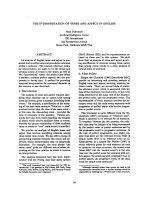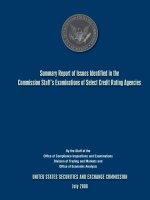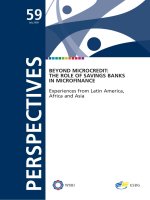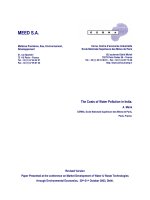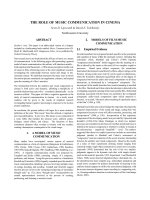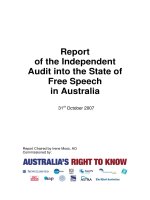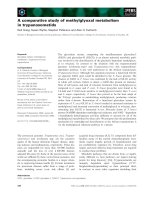Report of the Independent Audit into the State of Free Speech in Australia potx
Bạn đang xem bản rút gọn của tài liệu. Xem và tải ngay bản đầy đủ của tài liệu tại đây (1.27 MB, 336 trang )
Report
of the Independent
Audit into the State of
Free Speech
in Australia
31
st
October 2007
Report Chaired by Irene Moss, AO
Commissioned by:
This page has been intentionally left blank
This page has been intentionally left blank
i
INDEPENDENT AUDIT OF THE STATE OF FREE SPEECH
IN AUSTRALIA
EXECUTIVE SUMMARY
There are no executive summaries for chapters 1, 2 and 3. Those chapters are of a summary
nature themselves.
Chapter 4: Access to information
Government policy documents at all levels commit to providing information as widely as
possible. However, honouring that commitment is subject to the government’s discretion.
Unfortunately there is mounting evidence that the lure of political advantage increasingly
trumps principles of democratic transparency when governments decide to withhold or bias
the release of information.
Some types of information require protection from disclosure. As well as privacy and
commercial interests, information of potential security significance also needs protection.
Governments strictly limit documents on security grounds: policy “is to keep security
classified information to the necessary minimum”. But over-classification limits information
available to the public. It also imposes unnecessary, costly administrative arrangements and
may bring security procedures into disrepute if classification is unwarranted. In a report in
2000, the Australian National Audit Office found that all organisations it audited incorrectly
classified files, with over-classification the most common fault.
Public interest immunity
Public interest immunity has been relied on by government agencies, under both the
common law and statute law, to refuse to provide documents or give evidence in court on the
basis that it would be contrary to the public interest to do so. The claim is also made by
governments on occasions to refuse to release documents to or answer questions from MPs.
Claims to public interest immunity differ in the way courts and parliaments treat them.
Public interest immunity claims also extend to the functions of governments. One way of
ensuring accountability of government is scrutiny and review by upper houses of Parliament
(except in Queensland and the territories which do not have upper houses) of legislation,
appropriation Bills and large government contracts, to use a few examples. Much of this is
done on the floor of the house or in committees, in which the major parties and independents
take part. This process also helps the greater flow of information through Parliament to the
public, usually with the media as the vehicle.
But the practice of the Federal Government, particularly since it gained control of both
houses of Parliament, has been roundly criticised.
ii
Journalists’ experiences
Overwhelmingly journalists complain they are denied access to information, particularly
background information on government decisions. They say the flow of information is
controlled, largely because of the centralisation of the source of government information. In
what now appears to be the majority of cases, public servants are prohibited from giving
journalists information directly. Journalists are either referred to the department’s media
section or the minister’s office. Their experiences and comments provide a telling account of
the flow of information from governments at all levels. This audit sets out comments from
journalists across the country. Save for some slight editing, the words are reproduced
verbatim.
News conferences
Canberra journalists say the news conference system has become worse under the Howard
Government. Gallery journalists complain that conferences—now conducted in the US
Presidential style—are short and do not allow free-ranging questions. The politician will say
what he/she wants to say and not allow questions or provide only trivial answers. The media
is usually given short notice, allowing journalists little time to research and prepare
questions. Some journalists say certain media representatives are selected, rather than all
being given the opportunity to attend. This style of conference allows the politician to side-
step important issues by giving “soft” answers. In the words of one, the present type of
conferences is “… not submitting yourself to scrutiny”. One senior journalist described it as
“government by announcement”.
Talkback radio
Canberra-based journalists complain of the trend of the Prime Minister to use talkback radio
to their detriment. These broadcasts allow politicians to make political statements without
close questioning by political journalists. One journalist described them as easy avenues to
reach a mass audience without facing “more difficult or less convenient questions on the
national agenda”.
Spin
Journalists contributing submissions to this audit say that government PR staff all too often
try to block or frustrate, rather than facilitate, their inquiries. Directing all inquiries through
ministers’ offices, restricting the government employees with authority to speak to the
media, demanding that all questions be submitted in writing, taking a long time to respond to
questions, offering answers of little value, and completely ignoring some questions, are the
common features in a long list of grievances submitted to this audit.
iii
Chapter 5: Protecting whistleblowers and journalists’ sources
No current legislation defines the terms “whistleblower” or “whistleblowing”, but eight Acts
and three Bills across Australia deal with the subject.
Whistleblowing law in Australia varies widely between the nine jurisdictions—federal, six
states and two territories. The types of disclosers and the nature of disclosures vary; the level
and forms of protection vary; and the type and severity of penalties for reprisals, including
breaches of employer obligations, vary.
There is significant inconsistency in whether a law applies to the public and/or private
sector.
The limited scope of the whistleblower legislation has been criticised. Comprehensive
application to all sectors needs debate. A clear public sector focus may be appropriate.
There is significant inconsistency in the types of wrongdoing about which disclosures can be
made that trigger the relevant legislation. In some circumstances the conduct about which a
disclosure is made is too general and outside the realm of whistleblowing. In other cases
such conduct is too narrowly defined, for example, only unlawful behaviour. Only three laws
(South Australia, Queensland and Western Australia) take a comprehensive approach to
identifying the public sector wrongdoing that qualifies disclosures.
There are significant gaps in the nature and extent of protection provided. Whistleblowers
need to be relieved of potential liability for their disclosure, such as the risk of disciplinary
or criminal prosecution for unauthorised disclosure of information or civil action such as
defamation. Damages are only available through employment, anti-discrimination or EEO
tribunals. Only three jurisdictions provide injunction or compensation remedies for
potentially or actually aggrieved whistleblowers.
The Federal Parliament has traditionally lacked a general power to implement
comprehensive whistleblower legislation. It has used the corporations power to provide for
protection in specific private sector areas. However, it does not lack power to legislate to
protect its own employees and contractors.
It might be appropriate to have a single national legislative regime dealing with all aspects of
whistleblowing (public and private). The two states (Queensland and South Australia) which
have tried have produced unsatisfactory results.
A key issue arises from the distinction between leaks in general and the sub-class of leaks
that are public interest disclosures (PIDs). In short, it is logical that if there is a public
interest in such disclosures then their messengers should be encouraged and protected rather
than shot at.
A strong case can be made for uniform public interest disclosure legislation. A new-model
federal law should at least protect whistleblowers who disclose to the media after making a
reasonable attempt to have the matter dealt with internally, or where such a course was
impractical.
Journalists in Australia are inadequately served by shield legislation and the common law in
relation to their ability to protect the identity of their sources.
iv
Particularly in relation to the new shield provision in the Commonwealth Evidence Act, since
any unauthorised communication of information remains criminalised even where it is a
PID, this exception seems bound to apply in nearly all cases of leaks of information to
journalists. Hence the privilege apparently offered is a sham.
Improving Australian shield laws will be to little effect in relation to government
information if the sources whose identity those laws are designed to protect face exposure
through a conjunction of political forces. That conjunction, at least at Commonwealth level,
involves a dogged refusal to provide substantial legislative protection to whistleblowers
together with a relentless determination to track down the source of disclosures which the
aforementioned refusal ensures remain “unauthorised”. That determination was perhaps best
expressed by the Secretary of the Prime Minister’s Department, Peter Shergold, who was
quoted as saying “if some people seem surprised that I have called in the police to deal with
leaks, they shouldn’t be—I always have and I always will”.
There are in essence two approaches to shield legislation and the guidance it provides the
judiciary. The first rests on the presumption that disclosure of journalists’ sources is
necessary unless there is some case made out to resist disclosure. In short, the onus is on the
journalist. The alternative is that disclosure of sources is not necessary and a case must be
made out on the basis of some compelling public interest as to why the presumption against
disclosure should be overturned.
Clearly Australia has a long way to go before its legislation embodies the desirable second
alternative.
There is a good case for an effective shield law regime based on a presumption that sources
should not be revealed and journalists could be ordered to do so by a judge only on strictly
limited grounds of compelling public interest.
Chapter 6: Freedom of information
FOI laws work effectively and reasonably consistently when they are used to provide access
to personal information about the applicant. A range of factors limit their effectiveness in
ensuring access to documents relevant to government accountability—the very reason they
were set up in the first place.
No government, federal, state or territory, has taken sustained measures to deal with an
enduring “culture of secrecy” still evident in many agencies. There are few visible,
consistent advocates of open government principles, within government systems and
leadership on FOI is lacking.
FOI performance is patchy across all governments. In some agencies applications are
managed in a professional manner and decisions on access reflect the law, its spirit and
intent. In other cases the FOI process involves delay, high cost, and what could be seen to be
obstruction, often suggesting attempts to protect politically sensitive information.
v
Delay:
• Some requests can take months or even years to resolve despite the fact that a limited
statutory deadline applies to the processing of applications.
• A request in April 2005 to the Department of Defence for documents on Australia’s
position regarding rendition is still awaiting a determination.
• An application was made for the results of public opinion surveys carried out for the
Department of Employment and Workplace Relations to assess the success of about
$32 million spent advertising the WorkChoices law. The department deferred access
until later this year, presumably after the election. The reason for the delay was that a
government committee wanted to see all the results of the surveys together. The
department decided to withhold them all until such time. Using this argument, no
results of any surveys ever need be released provided the government claims to have
plans to conduct further surveys.
• In 2005-2006, 25 per cent of applications to federal agencies for non-personal
documents took longer than 90 days to process, three times longer than the statutory
time of 30 days. The Victorian Ombudsman reported only 56 per cent of decisions by
government departments in 2003 were made within the statutory time of 45 days.
Nearly 21 per cent of decisions took more than 90 days. Over 40 per cent of requests
being handled by Victoria Police at any time during the period covered by the
Ombudsman’s review were taking more than 45 days.
High cost:
• The Herald Sun abandoned a two-year campaign seeking information about travel of
federal politicians after it was quoted a fee of $1.25 million, which amounted to 32
years of full-time work for a public servant. The Administrative Appeals Tribunal
accepted that those named in the list would need to be consulted before disclosure, but
the Government was entitled to seek payment for the time spent in consultation and
decision-making.
• Decision making time chargeable to the applicant can run to hundreds of hours and
thousands of dollars in charges. Included in an estimate of fees of $12,718 for access to
documents about the effect of global warming on the Great Barrier Reef are charges for
538.95 hours for making a decision on the status of the documents.
Federal – State Differences
Associate Professor Anne Twomey of the University of Sydney School of Law carried out
research on the Australia Acts 1986. The Acts were passed by all Australian parliaments to
sever residual links with the United Kingdom. She reported:
The Commonwealth was a completely different story [from other jurisdictions
involved]. After a bureaucratic process of meetings, submissions, reports,
consultations, vettings, demands for ASIO security clearances, and scandalous delays
lasting almost three years, only a small proportion of the Commonwealth’s documents,
described by officials as ‘the innocuous ones’, were released by the Commonwealth
vi
Attorney-General’s Department. The Prime Minister’s own department still has not
managed to release a document after three years. Access to legal opinions was also
formally denied by the Attorney-General’s Department, despite the fact that they were
more than 20 years old. In contrast, the states, the United Kingdom and the Special
Committee of Solicitors-General released their legal opinions.
The existence of powers in the Federal Act for the issue of conclusive or ministerial
certificates, and limited rights of review of the decision to issue a certificate, is inconsistent
with the scheme of the legislation.
Common Problems
Claims that FOI is achieving its intended purpose, including opening government activities
to scrutiny and criticism, are not substantiated by the evidence.
In the federal arena in particular, FOI is marked by a high degree of legal technicality which
dominates considerations about whether disclosure is in the public interest, or may
demonstrate harm to an essential public interest.
There are inadequacies in the design of the laws; too much scope for interpretation of
exemption provisions in ways that lead to refusal of access to documents about matters of
public interest and concern; cost barriers to access; and slow review processes that often fail
to provide cost-effective resolution of complaints.
Given the original objectives of FOI, there is a need for clarification about the extent to
which advice to government should be based on notions of confidentiality. While some
confidentiality about some advice in some circumstances may be appropriate, blanket claims
seem counter to the objective of informing public debate, and accountability for government
decisions.
Chapter 7: Anti-terrorism and sedition
Australian anti-terrorism laws have been designed to significantly reduce the judicial watch
on the executive power inherent in their operation. Even where such oversight is permitted,
the laws restrict the media’s ability to report and curtail the ability of people to communicate
with journalists and others. While we discern general acceptance (including among media
organisations) that threats from terrorism require a solid response, the essential issue is the
extent to which it is reasonable to sacrifice basic freedoms in the cause of defending them.
The effect of anti-terrorism legislation means we are almost certainly unaware of the number
of cases in which the legislation has been applied and the extent to which reporting on them
has been prevented.
At least seven federal Acts provide for substantial penalties for those who breach their
provisions.
The Criminal Code Act 1995 defines a “terrorist act” in section 100.1. The definition is
broad. Vagueness in this area always invites the apprehension (if not ultimately the reality)
of abuse in those, including the news media, potentially affected by the legislation.
vii
The Australian Security Intelligence Organisation Act 1979 provides for the issue of
warrants to question and detain people (clearly including journalists) where it is reasonably
believed the warrant “will substantially assist the collection of intelligence that is important
in relation to a terrorism offence”. Again, this is a broad definition, characterised by
vagueness.
The obvious problems with section 9A of the Classification (Publications, Films and
Computer Games) Amendment (Terrorist Material) Act 2007 relate to the vagueness of the
phrases “indirectly counsels or urges” and “indirectly provides instruction”.
An example: Following clearance by the AFP, the DPP and the Classification Board, of
eight books seized from Muslim bookshops, the federal Attorney-General, Philip Ruddock,
in July 2006 referred the books to the Classification Review Board. It refused classification
of two books on the basis that they promoted “jihad” and incited terrorism. The other six
were given unrestricted classification. These were the first two books banned in Australia
since 1973.
Once tried in relation to terrorism, the urge to ban can spill into other areas. In January 2007,
after approval of Dr Phillip Nitschke’s euthanasia manual The Peaceful Pill Handbook, the
Attorney-General referred it to the Classification Review Board. This resulted in the book
being banned at the end of February 2007.
Sedition
The last prosecution for sedition in Australia was in 1960 when Brian Cooper was sentenced
to two months’ jail with hard labour for urging the natives of Papua New Guinea to demand
independence from Australia. This followed the two previous cases, both in NSW—an
unsuccessful prosecution in 1953 and the sentencing in 1950 of William Burns to six
months’ jail for writing seditious articles.
The Anti-Terrorism Act (No. 2) 2005 repealed most of the existing sedition provisions of the
Crimes Act 1914 and replaced them with new provisions. These new provisions have been
widely criticised, especially in submissions to the Australian Law Reform Commission
review in 2006. Dr Ben Saul of the Gilbert+Tobin Centre of Public Law at UNSW submitted
that there was no case for “modernising” sedition law because of a history of its
manipulative use against legitimate political opponents; the prosecution of trivial statements
which lack any real connection to violence; its propensity to unjustifiably interfere with
freedom of expression and opinion; its historically vague, uncertain and unpredictable scope;
its modern redundancy in light of many overlapping (but more precisely framed) offences;
its disuse over many decades; and widespread public unease about—and considerable
ridicule of—sedition offences.
viii
The principal problems with the provisions have been identified as:
• the imprecision of the key verb “to urge”;
• it is no longer necessary to prove an intention to promote ill-will and hostility to
establish seditious intent;
• there is no requirement that the person “urging” have any particular intention, such as
in the previous Crimes Act;
• violence need not be violence incited within the Australian community—it would
suffice that the urging occurred to a group of a different nationality or political opinion
to use force against any other person in any other place, the effect of which would
“threaten” the peace of the Commonwealth;
• the urging need only be to engage in conduct that provides assistance to a (vaguely
defined) organisation engaged in armed hostilities against the Australian Defence
Force. This could extend to verbal support for insurgent groups who might encounter
the ADF in their country;
• inciting terrorism is unlawful under pre-existing law. This indicates these provisions
will extend to the murkier concept of “indirect urging” as well as condoning or
justifying terrorism or even abstract opinions about that conduct;
• section 80.4 extends the geographical reach of the provisions via the Criminal Code so
any “offence will be committed whether or not the conduct or the result of the conduct
constituting the offence occurs in Australia”. It covers any person of any citizenship or
residence. There is no foreign law defence. It in effect creates a universal jurisdiction.
Chapter 8: The justice system
Despite its explicit acceptance by governments, the judiciary, the media and the public, the
principle of open justice has been eroded over recent years.
A main contributor has been the threat of terrorism. However, limits on access by the media
to court documents and information and an increase in suppression orders (particularly in the
lower courts) are examples of where the principle is seen as threatened.
Journalists report not only difficulty getting access to court documents and information, but
also a lack of clear guidelines on such access. They sometimes report a virtual
capriciousness by some members of the judiciary and court officers when deciding whether
to allow access.
There is no uniform approach to the rules of access—even within a jurisdiction. For
example, the Victorian Supreme Court has a clear practice but the Magistrates’ Courts do
not. One Magistrate’s Court may make access easier, but a court in a nearby suburb may
make it extremely hard. It often depends on the attitude of the magistrate or registry staff.
In the jurisdictions with media liaison officers the system appears to work more efficiently
and more predictably.
There is also lack of uniformity about rules relating to the identification of children, whether
they are accused of crime, victims of crime or witnesses. Nor is there uniformity on the
naming of the accused in cases involving children, which could identify the child or children
involved.
ix
Across all jurisdictions there are problems with suppression orders. Sometimes there is even
difficulty in getting clear information on whether a suppression or pseudonym order has
been made and the reasons and legal bases for making it.
Courts appear to be making suppression orders far more often. The scope, precision and
duration of the orders is sometimes not given or not easily found out. Different practices and
methods across jurisdictions for informing the media that a suppression order has been made
or amended sometimes expose the media unnecessarily to an inadvertent breach of the order.
There is confusion about the standing of media organisations to appear in relation to the
making of, amending of or appeal against suppression orders.
The lack of uniformity in the legislation and rules and practices in relation to both access to
court information and suppression orders poses added problems for media organisations
which operate across borders and creates anomalies from one jurisdiction to the next.
Chapter 9: Privacy and defamation
Privacy
Media organisations and journalists recognise privacy as a value to be respected.
It is a right recognised in both international and Australian law and both it and freedom of
expression are important in a democratic society.
The concept of privacy is still evolving in the light of technological changes that present new
challenges about intrusions into private life.
Even without these challenges, Australia’s privacy laws are complex and confusing, with
large areas of overlap, gaps and inconsistencies. They have been referred to the Australian
Law Reform Commission, which should give an opportunity for analysis, discussion and
debate about how best to regulate, particularly in areas associated with personal information.
A final report is due in March 2008.
Proposals for some changes to aspects of the system of regulation of the media concerning
compliance with privacy requirements are currently the subject of public consultation. A
proposal for a law on breach of privacy is also at the discussion stage. The cause of action
proposed is not directed solely towards the media, but deals with a range of invasions of
privacy.
Media organisations have made or are making submissions to both the Australian and NSW
Law Reform Commissions arguing that the case has not been made out for a new law on
invasion of privacy, either in NSW or more broadly in Australia.
They submit that the case for such a law has not been made, that the introduction of a
statutory right to privacy “would substantially alter the balance by placing fundamental
restraints on the media’s role in upholding freedom of communication”, and that existing
privacy and publication laws adequately protect privacy rights.
x
Confusion and uncertainty about the operation of privacy laws has led to claims that
information in certain circumstances cannot be disclosed “because of the Privacy Act”
(BOTPA).
While BOTPA may be a myth, frequent resort to this mistaken justification for refusal of
access to information strongly supports the need for reform and simplification of the laws.
The myth has been reality many times when privacy laws have been cited as reasons for
refusing access to information, the disclosure of which would arguably be in the public
interest.
The Australian and NSW LRCs have acknowledged the importance of freedom of
expression and the need to retain a right to publication in the public interest.
Defamation
Defamation law provides important protection against damage to reputation. The uniform
laws now in place are a significant improvement in balancing freedom of expression and the
right to reputation. Evidence suggests a reduction in the writs issued against media
organisations since the laws came into effect in January 2006.
However, some have expressed the view that the reforms did not go far enough. The
Australian Society of Authors, for instance, says:
Australia’s authors suffer more than most from censorship because we cannot afford to
defend our legal rights, truncated as they are. Not one book in a thousand earns the
author and publisher enough to cover the average cost of defending a defamation suit,
$140,000.
And to the disappointment of some, Australian defamation law contains no “public figure”
test of the kind available in the United States.
Australia also appears to lag behind other countries in ensuring protection against liability
where matter has been published in the public interest after reasonable precautions have been
taken by the publisher.
It has been suggested that it is still too early to tell whether the uniform laws, in practice,
represent a better balance of the rights and interests of individuals and others who write and
publish. Much will depend on the approach taken by the courts.
CONTENTS
1. BACKGROUND 1
1.1. Australia’s Right to Know Coalition 1
1.2. The independent audit of the state of free speech in Australia 1
1.2.1. Terms of reference 1
1.2.2. What the audit did not cover 2
1.2.3. The audit process 3
2. THE ROLE OF THE NEWS MEDIA 5
2.1. Role of the news media in a democratic society 5
2.2. Freedom of speech 5
2.3. What are the limitations of access to, and publication of, information and
comment, including rights and responsibilities? 6
2.4. The Australian context 6
3. THE STATE OF FREE SPEECH 9
3.1. Australia ranked 28
th
in international press freedom index 9
3.2. Secrecy in government 10
3.3. Freedom of Information 10
4. ACCESS TO INFORMATION 13
Executive Summary 13
4.1. Background 15
4.2. Availability of and access to information 16
4.3. The internet and government information 18
4.4. Public interest immunity 19
4.5. Journalists’ experiences in obtaining information from governments 23
4.5.1. Secrecy generally 23
4.5.2. All questions directed to the media unit or the ministers office 24
4.5.3. A case study: BOTPA—“Because of the Privacy Act” 28
4.5.4. Media management 29
4.5.5. Access to information about ministers and members of parliament 30
4.5.6. Budget papers 31
4.5.7 No information available—try FOI 31
4.5.8. Issues with particular organisations 31
4.5.9. Examples of delays 33
4.5.10. Other problems with getting access to information 34
4.6. Other examples 35
4.6.1. All-in news conferences 36
4.6.2. Doorstop conferences 37
4.6.3. Talkback radio 37
4.7. Spin 38
Annexure A 43
Annexure B 46
Annexure C 48
5. PROTECTING WHISTLEBLOWERS 53
Executive Summary 53
5.1. Introduction 55
5.2. Public interest disclosure (PID) legislation overview 56
5.3. Lack of extension of protection to disclosures to the media 57
5.4. Clarification and consistency in definition of whistleblower and whistleblowing 57
5.4.1.Clarification and consistency as to scope and focus of whistleblowing 59
5.4.2. Clarification and consistency as to motive 59
5.4.3. Clarification and consistency as to types of wrongdoing covered 59
5.4.4. Lack of consistency in the evidence required to support a disclosure 60
5.5. Lack of protection 60
5.6. Legislative framework 61
5.7. Limitations on the protection of people who leak information without authority
to the media 61
5.8. Codes of conduct 62
5.9. Commonwealth legislation - shortcomings 64
5.11. Protection of journalists’ sources - ‘shield’ law 68
5.12. Public interest in protecting journalists’ sources 70
5.13. Rendering Australian shield law hollow 70
5.14. Overseas ‘shield’ legislation 71
5.15. Alternative approaches to shield legislation 73
5.16. Conclusion 73
Annexure A 79
6. FREEDOM OF INFORMATION 89
Executive Summary 89
6.1. Background 93
6.2. FOI and the media 93
6.3. Does FOI work? 96
6.4. Reviews of FOI 100
6.5. Barriers to access to information under FOI 102
6.5.1. Continuing culture of secrecy 103
6.5.2. Political influence on decision-making 104
6.5.3. Pro-disclosure bias 107
6.6. Scope of legislation 108
6.6.1. Relationship with privacy and secrecy laws 109
6.7. Recordkeeping 112
6.8. Exemptions 114
6.8.1. Cabinet documents 116
6.8.2. Business affairs 117
6.8.3. Internal working documents 117
6.8.4. Conclusive certificates 120
6.8.5. Powers of review 122
6.9. Quality of decisions 123
6.10. Excessive delays and drawn-out reviews 129
6.11. High cost barriers 132
6.12. Review initiatives in 2007 135
6.13. International comparisons 136
6.14. Scope for change 137
6.15. Assessment 138
7. ANTI-TERRORISM AND SEDITION 153
Executive Summary 153
7.1. Introduction 155
7.2. Commonwealth terrorism legislation affecting news media 156
7.3. The re-invigoration of sedition law 160
7.4. Prosecutions using anti-terrorism laws 162
7.5. Anti-terrorism and sedition legislation overseas 164
Annexure A 173
8. THE JUSTICE SYSTEM 183
Executive Summary 183
8.1. The principle of open justice and the courts 185
8.2. Access to court and court documents 187
8.3. Restrictions on reporting and suppression orders 194
8.3.1. General 194
8.3.2. Statutory restrictions 195
8.3.3. Children 195
8.3.4. Jurors 198
8.3.5. Family Court proceedings 198
8.3.6. Committal and bail proceedings 198
8.3.7. Prisoners 198
8.4. Suppression orders 199
8.4.1. Superior courts – inherent powers to restrict access to or reporting of
proceedings 200
8.4.2. Inferior courts and tribunals: implied powers 201
8.4.3. Circumstances in which an order may be made 201
8.4.4. The Victorian situation 205
8.4.6. Suggested legislative changes to suppression order legislation 206
8.5 Non-publication orders in other countries 208
8.6. Contempt of court 212
8.7. Observations 214
Annexure A 218
Annexure B 228
Annexure C 237
9. PRIVACY AND DEFAMATION 257
Executive Summary 257
9.1. Privacy 259
9.1.1. State of privacy laws 260
9.1.2. Media exemption 262
9.1.3. Cause of action for breach of privacy 264
9.2. Defamation 267
9.3. Other legal action 269
9.4. Assessment 270
AnnexureA 272
Annexure B 282
Acknowledgments 289
Reference List 293
This page has been intentionally left blank
1
CHAPTER 1
BACKGROUND
1.1. Australia’s Right to Know Coalition
In May 2007 Australia’s leading media organisations formed a coalition called “Australia’s
Right to Know”. The coalition is concerned about what it sees as an erosion of free speech
at all levels of government over recent years. This historic partnership of print and
electronic media aims to try to tackle what the CEO of News Limited, John Hartigan,
describes as “… an alarming slide into censorship and secrecy that has reduced what
ordinary Australians can and can’t know about how they are governed and how justice is
dispensed”.
The coalition members are News Limited, Fairfax Media, FreeTV Australia, commercial
radio, ABC, SBS, Sky News, ASTRA, West Australian Newspapers, the Media,
Entertainment and Arts Alliance (MEAA), AAP and APN News and Media.
As part of its campaign, the coalition funded an independent audit on the state of media
freedom in Australia.
At its launch, the coalition said the report “will form the basis of a campaign of public
consultation and debate with government and opposition parties and the judiciary”.
1.2. The independent audit of the state of free speech in Australia
The audit team was Irene Moss AO as chair, Peter Timmins as deputy chair and Jane
Deamer as research director. Erin Tennant and Geoff Briot carried out some research and
took part in writing the report. Alison Larsen assisted the research team and Johanna
Dickson provided administrative support.
1.2.1. Terms of reference
The audit was asked to look at limitations on, and threats to, free speech and press freedom,
in particular federal, state and territory laws that have an impact on media access to and
dissemination of information and the public’s right to be informed.
The audit examined attempts by government to control the media in its reporting functions;
constraints in current laws; and issues arising from their implementation and interpretation
that have this effect. In particular:
• access to government information, including freedom of information and associated
laws;
• access to information about proceedings in the courts, including suppression orders
and the use of contempt laws;
• the seizure of records, use of subpoenas and protection of journalists’ sources;
2
• protections for, and liability of, whistleblowers and others who disclose
government-held information;
• anti-terrorism and sedition laws;
• defamation and privacy laws.
1.2.2. What the audit did not cover
Issues of concern to media organisations, practitioners and others that, given the time and
resources available, did not permit us to cover in any substantive way are listed below. In
some cases we considered them to be outside the scope of our terms of reference. It may be
that further research or comment is required about, for example:
• Whether there should be a federal or states Bill or Charter of Rights.
• Media ownership and the concentration of media.
• How well the media do their job and what they do or do not cover.
• Issues of alleged bias and/or balanced reporting or opinions.
• Changes and challenges arising from the growth of electronic journalism.
• How legislation and practices may constrain the public generally and, in particular,
non-government or quasi- government organisations. We include in this charitable
institutions, human rights or community organisations, universities and academics
and rights of the public to demonstrate against governments (such as the controls at
the APEC meeting in Sydney in September 2007).
• Increased resort to litigation or the threat of litigation by commercial interests said
to be designed to limit or constrain public debate. This includes such things as
“Strategic Litigation Against Public Participation” (SLAPPs), and changes to the
secondary boycott provisions of the Trade Practices Act to permit the Australian
Consumer and Competition Commission to take class actions on behalf of business
interests against protesters who they allege have affected their commercial
operations.
• Government funding of publicly owned media and any alleged influence over
content and operations.
• The capacity of the financial power of increased government advertising to
influence media coverage of government activities.
• Censorship, classification and content regulation (except as it relates to anti-
terrorism measures.
• Anti-vilification.
3
1.2.3. The audit process
This was not a public inquiry. However, if anyone outside the media or academia expressed
an interest or view they were welcome to make submissions. A small number were
received.
Discussions were held with some media coalition members.
We researched relevant literature.
About 300 journalists and media lawyers were surveyed or personally interviewed or
consulted.
Academics were consulted and several submissions and published documents were
submitted and reviewed.
Discussions were held with or submissions received from interested parties such as the
Press Council of Australia and the Australian Privacy Foundation.
Legal research was conducted by some private law firms.
For those organisations and individuals who provided assistance, information, submissions
and/or documents, please see acknowledgments at the end of and in the body of this report.
This report has been compiled on the basis of the research and the consultations held.
Acknowledgment
While they provided assistance, information and support, there was no attempt by any of
the coalition members to interfere with or influence the scope or the result of our research.
The coalition members, like other individuals and organisations, were invited to make
submissions to the audit. Some did.
4
This page has been intentionally left blank
5
CHAPTER 2
THE ROLE OF THE NEWS MEDIA
2.1. Role of the news media in a democratic society
The role of the news media in a democratic society springs from the right of people to gain
information about matters of public concern. Australians, as members of a mature
democracy, claim a freedom to have a say in the workings of a government elected on their
behalf; an entitlement to debate the wisdom of government conduct; and to demand that
policymakers defend chosen paths of action. Our society is more likely to benefit from
good government, it is held, if decisions are open to public discussion.
Such a discussion relies on access to information. People participate effectively in a
democracy and may hold their government accountable only if informed well enough to do
so.
1
In this context the news media assume a special role as both a conduit and as a public
watchdog. Through print, radio, television and the internet, news organisations are well
placed to disseminate ideas and information. Their role is to gather and report news about
the operations of government and other issues of public interest. They are even regarded as
a “fourth estate” in the machinery of democratic governance, acting on behalf of the public
to bring to its attention any political, economic or administrative abuses of power.
2
In this
sense, the news media help people get enough material to contribute to political debate in
an informed and substantive way.
2.2. Freedom of speech
Journalists are not the only custodians of free speech. Everyone in a democracy has the
right to freedom of opinion and expression: to put across their views without interference
and to seek, receive and impart information and ideas through any channel. Such freedom
to communicate empowers us with knowledge about the society in which we live. It allows
for the discovery of truth over error and for people to exercise autonomy by making
informed choices.
Free expression also encourages a government to be answerable to its people. Indeed,
because of advances in internet communications, at no time in history have governments
been better able to answer directly to people, whether through online portals to government
agencies or popular websites such as MySpace and YouTube—and to do so without the
news media acting as an intermediary or filter.
While it remains the case that journalists enjoy special access to events such as news
conferences, court trials, war zones and disaster scenes, it is less apparent that they enjoy
rights of expression any wider than the principles of free speech that protect ordinary
people.
3
For the purposes of this audit, we will not distinguish between the rights of the
institutional press and those of ordinary, individual speakers who exercise their democratic
free speech rights through public protest, non-fiction books, academic research, speeches or
internet blogs.

